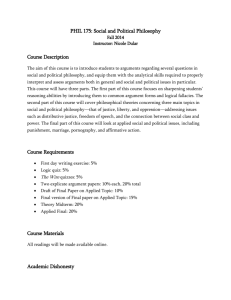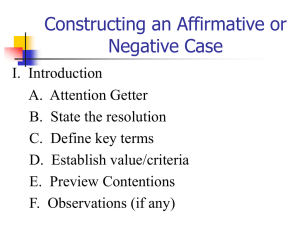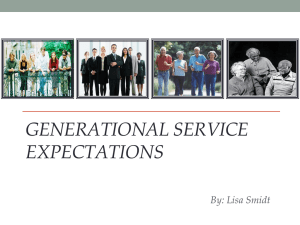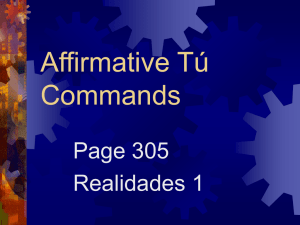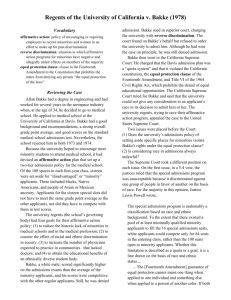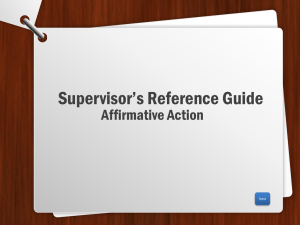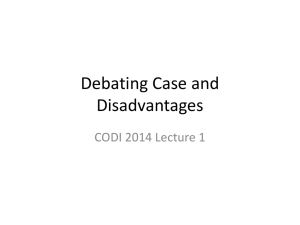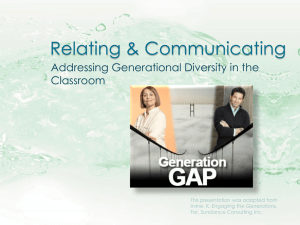EverythingPresentation3
advertisement
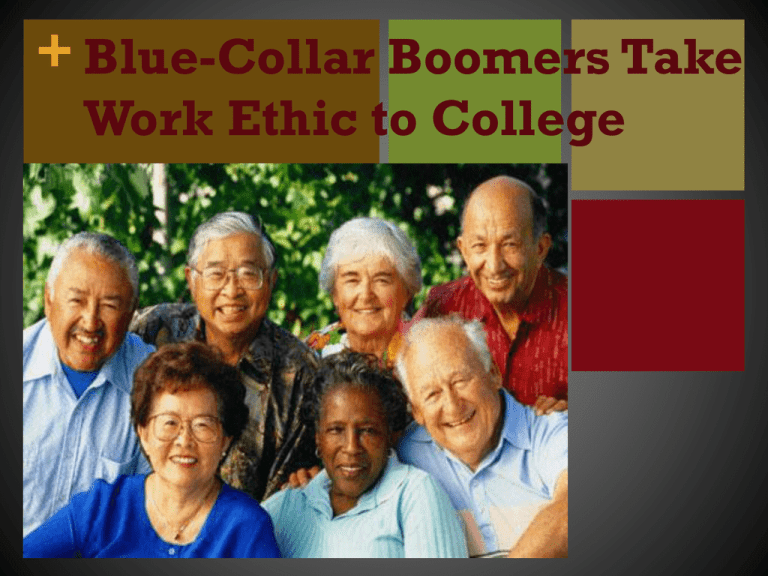
+ Blue-Collar Boomers Take Work Ethic to College + Baby Boomers Considered the generation after World War II More babies were born in 1946 than ever before: 3.4 million, 20 percent more than in 1945. According to the US Census, 77 million people were born between 1946 and 1964, which is defined as the baby boomer era At that time, they made up almost 40 percent of the nation’s population. The first baby boomer turned 65 on January 1, 2011. + What caused the Baby Boomers? Young males returning to the United States, Canada, and Australia following tours of duty overseas during World War II began families, which brought about a significant number of new children into the US. + Where they are today ? Today the Boomers make up 26.1 percent of the nation’s population As they grew older, some baby boomers began to resist this consumerist suburban ethos. They began to fight instead for social, economic and political equality and justice for many disadvantaged groups: African-Americans, young people, women, gays and lesbians, American Indians and Hispanics, for example. Today's Baby Boomers are between 40 and 62 years of age. Unlike the GI generation, who saved money and avoided debts, the Boomers are facing vanishing pensions. + • Discussion Question #1 What arguments is Libby Sander making in this selection? What factors account for the situation that she is describing? To what extent re these older American becoming students as matter of choice? As a matter of necessity? As Sander describes the situation, in what ways does social class intersect with the values that these students bring to school with them. + • Discussion Question #2 As noted, this articles was written before the economic downturn of 2008. How has the economic situation in the United States changed since that time Do you believe that these changes have had any influence on who is attending college or why? What evidence might you offer for your position? + • Discussion Question #3 What sorts of evidence does Sander present to support her claims? How might her article might have been different if she had relied only on, let’s say, statistics? How would the tone of the article, for examples, have been different? (For discussion of kinds of evidence, see Ch 4 on logical appeals and Ch 17 on what counts as Evidence.) + Discussion Question #4 • How does the presence of older Americans on campus change the nature of college life? How might the life presence experiences of people like Russell Kearney, David Cox, and Dannie Hill influence their behavior as students? How might they influence the nature of content of class discussion, for example? What advantages might there be to having a student population that it not all of a single age cohort? + Videos http://www.youtube.com/watch?v=LXEqQ gRxrZU http://www.youtube.com/watch?v=QsmNji 8hzBY +The Trouble With Diversity: How We Learned to Love Identity and Ignore Inequality + Diversity Capabilities and Disabilities Socio-Economic Sexual Backgrounds Orientation Age Gender Race Religion + Diversity works in effort to change the culture of an organization It establishes a sense of identity “At bottom every man knows well enough that he is a unique being, only once on this earth; and by no extraordinary chance will such a marvelously picturesque piece of diversity in unity as he is, ever be put together a second time.” - Friedrich Nietsche Affirmative Action + Originally used in Executive Order No. 10295, when John F. Kennedy signed the legal directives in 1961. It initially stated that federal contractors are required to “take affirmative action to ensure that applicants are employed, and that employees are treated during employment, without regard to their race, creed, color, or national origin.” Rooted In from discrimination-related issues 1978, the Supreme Court case, Regents of University of California v. Bakke, ruled that the use of racial “quotas” was unconstitutional. Hence, making affirmative action constitutional + Regents of University of California v. Bakke In 1978, the Supreme Court case, Regents of University of California v. Bakke, ruled that the use of racial “quotas” was unconstitutional. Hence, making affirmative action constitutional The case focused on the admission process of UC Davis’s Medical School, and their inflexible admissions quota. After being denied admissions twice, Allan Bakke, a white applicant with notably higher MCAT scores and GPA than the other admitted applicants, sued the university. + Wealth Inequality Also known as the “wealth gap” In 2008, the nation’s economy tanked, which lead to a great disparity between the rich and the poor Today, the richest 1% own over 35% of the nations wealth; leaving 65% of the nation’s wealth to be distributed among the remaining 99%. As the economy tripled, the middle-class slowly disappeared. + Diversity vs. Affirmative Action Often confused concepts Both deal with issues related to discrimination Affirmative action and diversity has distinct objectives and origins, but they are complementary in function. + Discussion Questions #1 • What, for Walter Benn Michaels, is the real issue that American society needs to confront? How, for him, does defining diversity in terms of a celebration of difference , especially ethnic difference, percent Americans form both seeing the real issue and doing anything about it? In what ways does our society’s focus on ethnic and cultural diversity necessarily perpetuate racism and biological essentialism (paragraph 10)? + Discussion Questions #2 • What and how are these issues relevant to discussions of diversity on campus in general? On the campus you attend? + • Discussion Questions #3 Later in this introduction, Michaels, a liberal, points out ways in which both conservatives and liberals in American public life, first, focus on racial or ethnic differences rather than issues of social inequality and, second, benefit from doing so. In a 2004 essay, “ Diversity’s False Solace,” he notes: We like policies like affirmative action not so much because they solve the problem of racism but because they tell us that racism is the problem we need to solve…. It’s not surprising that universities of the upper middle class should want their students to feel comfortable [as affirmative action programs enable and encourage them to do]. What is surprising is that diversity should have become the hallmark of liberalism. Analyze the argument made in this paragraph as a Toulmin Argument. Discussion Questions #4 + • How could you characterize Michael’s argument? In what ways is it an argument of fact? A definitional argument? An evaluative argument? A casual argument? A proposal? (For a discussion of these kind of arguments, see Chapters 8-12) + Videos http://www.youtube.com/watch?v=mFjZxB RCeec • • http://www.youtube.com/watch?v=JTj9Acwk aKM • http://www.youtube.com/watch?v=q8JEy bbei60 + Sources http://posiwid.blogspot.com/2010/01/what-is- purpose-of-diversity.html http://www.pbs.org/wnet/supremecourt/rights/lan dmark_regents.html http://www.cnbc.com/id/100780163 http://articles.latimes.com/2013/oct/10/business/l a-fi-lazarus-20131011 http://www.goodreads.com/quotes/tag/diversity http://www.encore.org/find/resources/our-next- chapter http://www.bbhq.com/bomrstat.htm
